FXC Intelligence data provides an updated picture of the growing cross-border payments market, with market sizing data up to 2032.
The size of the cross-border payments market can be challenging to fully assess, particularly in highly opaque sections of the market such as B2B payments. However, FXC Intelligence has developed market sizing datasets that provide a renewed picture of the total addressable market (TAM) for cross-border payments.
This has been newly refined for 2025 and now includes yearly projections and growth rates between 2024 and 2032, as well as revisions for the impact of the US tariffs, covering both the overall cross-border payments market and key market segments.
In this report, we outline the overall size of the market and how growth in key sectors is driving a significant upswing in cross-border payments between now and 2032.
The size of the cross-border payments market: 2024 to 2032
Built from the ground up to produce the most comprehensive market sizing data available, FXC Intelligence’s data shows that the non-wholesale cross-border payments industry had a global TAM of $40tn in 2024.
Also known as the retail cross-border payments market, this combines the cross-border global flows for large enterprise goods and services; small and medium-sized business (SMB) goods and services; consumer-to-business (C2B) payments; consumer-to-consumer (C2C) payments; and business-to-consumer (B2C) payments. By contrast, FXC Intelligence market sizing data shows that wholesale cross-border payments had a total market size of $154.7tn in 2024. Combined, this means that the entire wholesale and retail cross-border payments market had a TAM of $194.8tn in 2024.
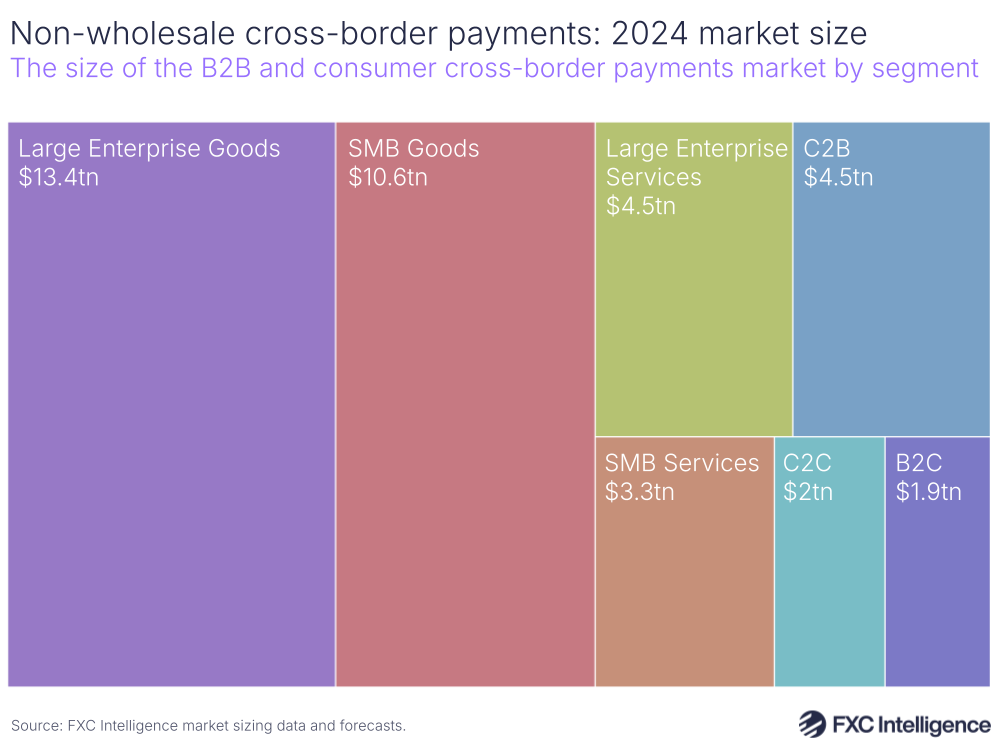
FXC Intelligence’s cross-border market sizing data includes forecasts up to 2032, and shows that the non-wholesale cross-border payments market is set to have a TAM of $62.3tn in 2032. This represents a 56% increase on 2024, and a compound annual growth rate (CAGR) of 5.7%.
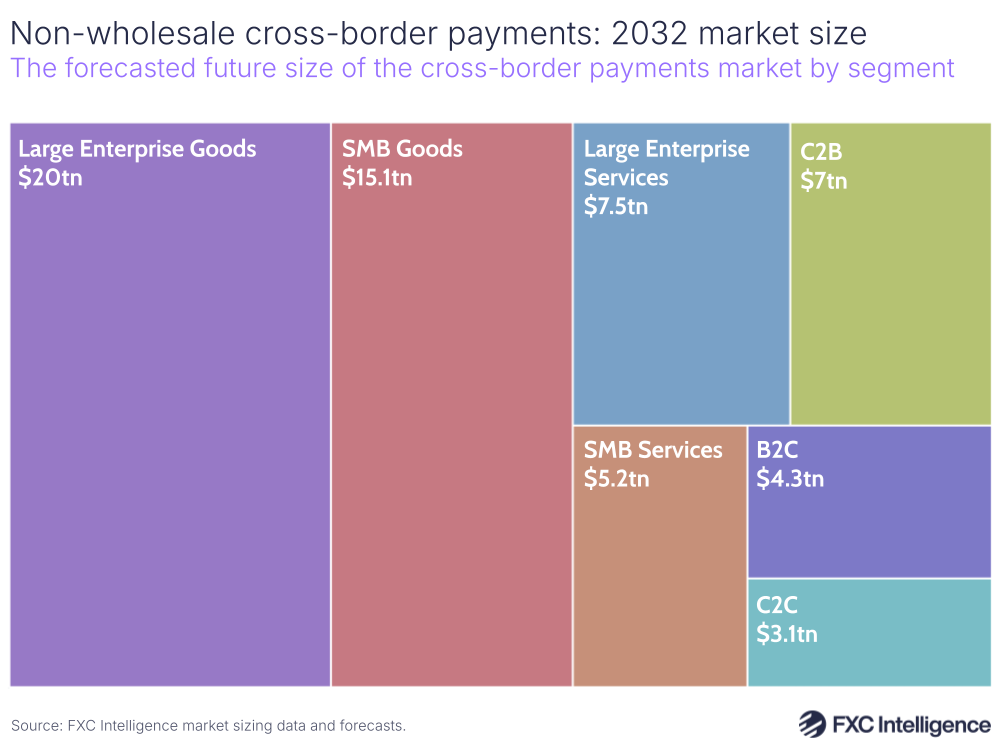
By contrast, the wholesale cross-border payments market is projected to reach $255.7tn by 2032 – a 65% increase on 2024 and a CAGR of 6.5%.
Meanwhile, the combined wholesale and retail market is set to see a 2032 TAM of $317.9tn, representing a 63% increase on 2024 and a CAGR of 6.3%.

Learn more about FXC Intelligence’s Market Sizing Data
How can FXC Intelligence’s market sizing data help my business?
Cross-border payments market growth trends
Looking at growth between 2016 through to 2024 shows the impact that the Covid-19 pandemic had on the cross-border payments market, and in particular the B2B side of the industry.
During Covid-19, B2B cross-border payments contracted significantly due to changing and tightening demands over the period. As a result, 2021 was a rebound year with unusually high year-on-year growth, which is not set to continue indefinitely.
Our models take account of the pandemic and show that while we are set to see continued growth throughout the 2020s, this will be at a shallower rate than was seen in 2021 and to a lesser extent 2022.
As we look toward 2030 and beyond, we see continued growth in all segments, although expect to see sharper growth in some compared to others. In B2B payments, large enterprise is set to grow at a faster rate than SMB, although B2C payments are set to see the strongest growth of all the segments covered.
In general, such growth will be aided by a number of factors. Innovations in digital payments, including the continued development of instant payment systems as well as enhancements using technologies including AI and blockchain, will continue to cut costs and reduce processing times, incentivising greater flows.
Ongoing regulatory evolution will also play a role. Harmonised internal frameworks such as PSD3 in Europe are facilitating smoother transitions, while the G20 Roadmap for Enhancing Cross-Border Payments, which began publishing benchmarking data in the last two years, is also set to reduce costs.
Meanwhile, increased consumer expectations of instant and transparent payments are driving providers across a wide range of market segments to enact technological upgrades, while the increased adoption of digital wallets, including PayPal, AliPay and Apple Pay, is driving greater penetration across both C2B and C2C transactions.
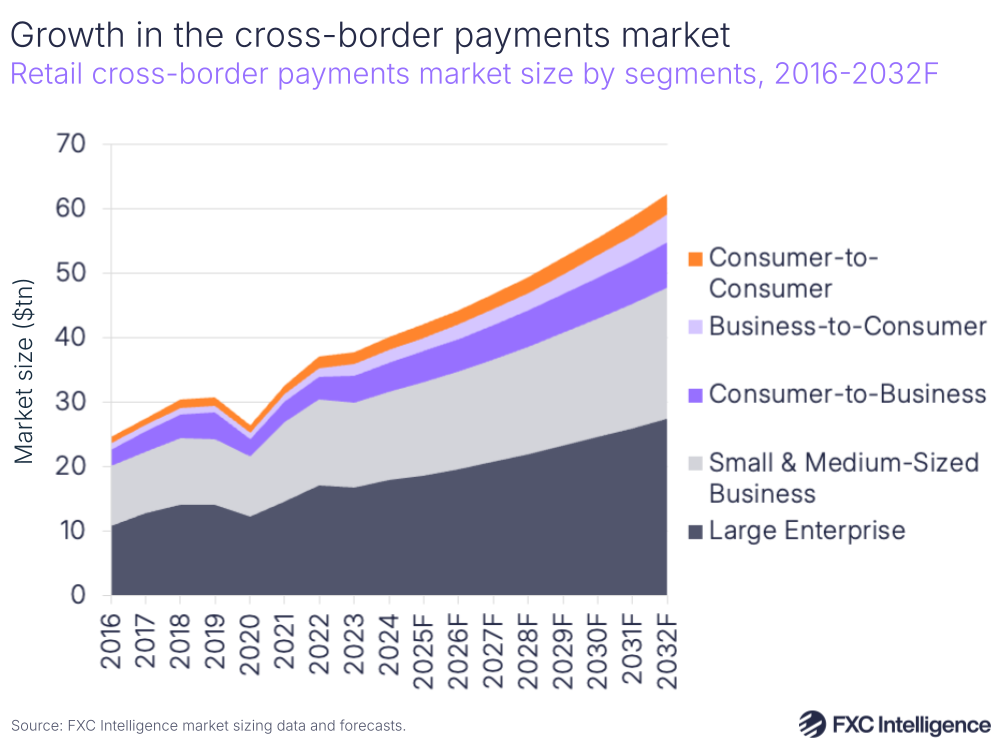
How have the tariffs impacted the cross-border payments market?
In April, the International Monetary Fund (IMF) downgraded global economic growth outlook in response to the US trade tariffs and related economic uncertainty. We have therefore revised our forecasts to take into account these changes, which has resulted in a lower overall market size over the next few years.
The total non-wholesale market for 2032 is now projected to be -$2.3tn lower than before the US tariffs were announced, with lower values projected for every year from 2025 onwards. 2025 itself now has a market size forecast -$0.6tn lower than at the start of the year.
This also translates into a lower CAGR for non-wholesale, with the CAGR between 2024 and 2032 now being half a percentage point lower than had previously been projected. However, the forecasts for wholesale cross-border payments remain unchanged.

Within non-wholesale cross-border payments, the changes to the forecasts are not equally applied to all segments. C2C and B2C payments have only seen very minor revisions to their forecasts, while C2B payments has seen modest downward revisions, with 2032 now being -$0.1tn lower than its forecast prior to the tariffs.
However, B2B payments has seen the majority of the reductions, with 2032’s forecast now being -$2.2tn lower and its CAGR between 2024 and 2032 dropping from 5.9% to 5.3%. Within this, large enterprise accounts for slightly more than SMB, with its forecast now being -$1.2tn lower in 2032, compared to SMB’s -$0.9tn drop.
Given the nature of the tariffs, B2B goods have seen a more pronounced drop than B2B services. While combined SMB and large enterprise services has seen a 2032 forecast drop of -$0.2tn, and a CAGR reduction of 0.2 percentage points, combined goods accounts for the majority of the forecast reduction. B2B goods is now projected to have a 2032 market size that is -$2tn lower than before the tariffs, with a CAGR that is 0.8 percentage points lower.
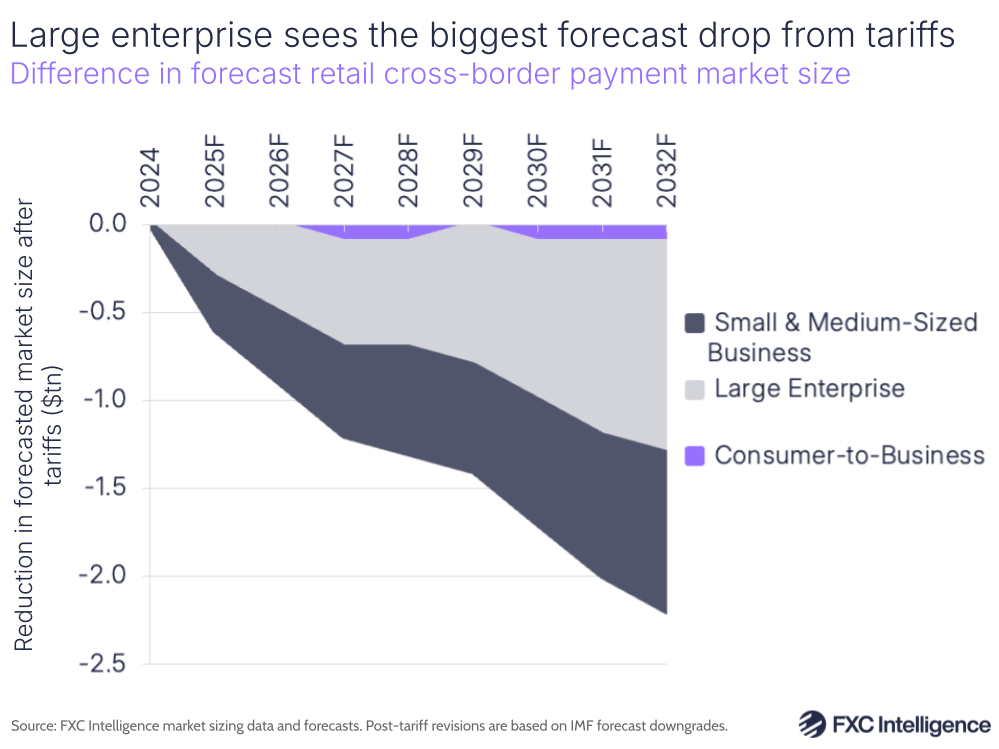
Learn more about Partnership Connect by FXC Intelligence
How can I find the right partners to help me enter a new country or region?
How big is the B2B cross-border payments market?
As of 2024, the B2B cross-border payments market had a total global size of $31.7tn, and is set to grow by 51% to $47.8tn in 2032, with a 5.3% CAGR. By contrast, B2B saw a CAGR of 5.8% between 2016 and 2024.
However, within this there is some variation between segments. For large enterprise, the overall global TAM for 2024 was $17.9tn, which is projected to grow by 54% to $27.5tn in 2032, with a 5.5% CAGR. Within this, large enterprise goods represents the largest B2B segment, with a 2024 market size of $13.4tn, climbing to $20tn in 2032. Meanwhile, large enterprise services had a 2024 market size of $4.5tn, which is expected to grow to $7.5tn in 2032.
By contrast, SMB overall had a 2024 global TAM of $13.8tn, which is forecast to rise to $20.3tn in 2032 – a growth rate of 47% and a CAGR of 4.9%. Within this, SMB goods had a 2024 market size of $10.6tn, rising to $15.1tn in 2032, while SMB services had a 2024 market size of $3.3tn, rising to $5.2tn in 2032.
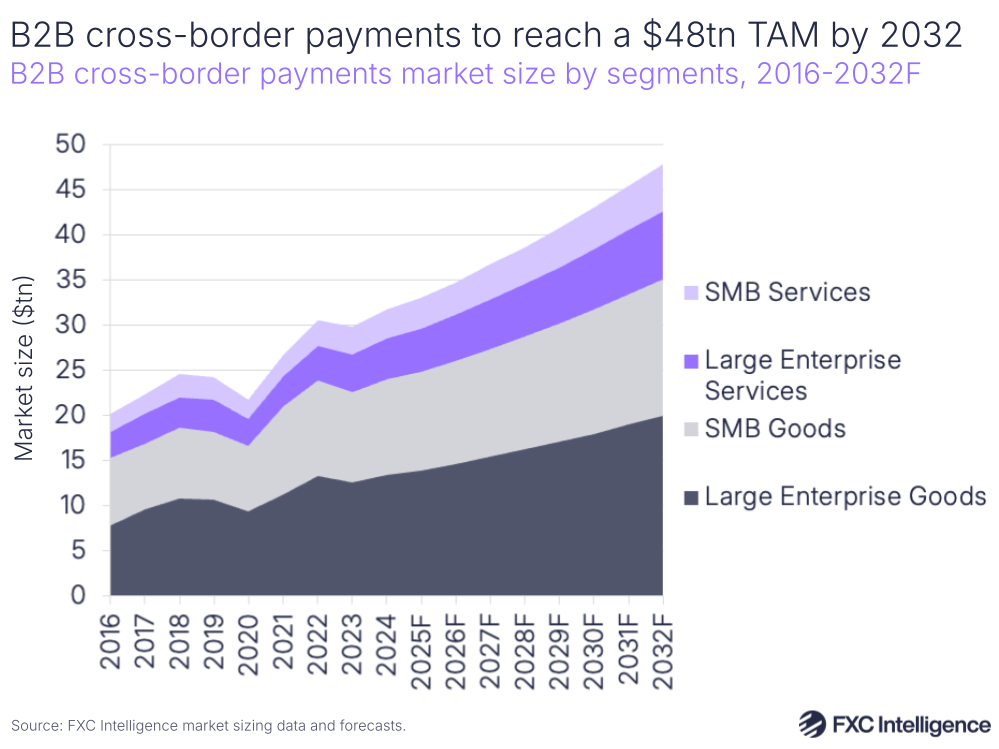
How big is the consumer-to-consumer money transfers market?
Also known as person-to-person (P2P) payments, the C2C payments market covers consumer money transfers, including both migrant remittances and high-value transfers.
While the overall C2C market is considerably smaller than the B2B cross-border payments market, it is still set to see significant growth over the next few years, driven by greater digitisation and infrastructure improvements, as well as changes in migrant behaviour. South Asia and Latin America in particular are emerging as key growth corridors for inbound remittances as a result of their large populations of migrant workers.
In 2024, consumer money transfers had a global TAM of $2tn, although this is set to grow by 57% by 2032, with a 5.8% CAGR. This sees the total market size projected to reach $3.1tn in 2032. While significant, this represents a slight slowing compared to growth over the last eight years. Between 2016 and 2024, C2C cross-border payments increased at a CAGR of 6.9%.
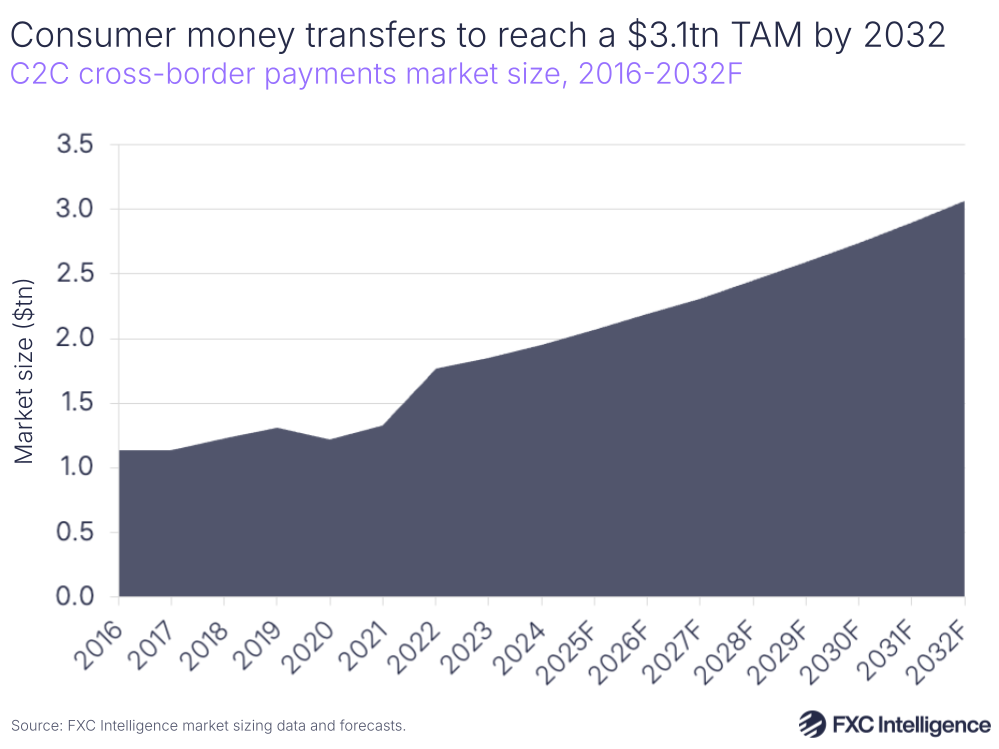
Learn more about FXC Intelligence’s Market Sizing Data
What is the market size for the corridors that matter to my business?
How big is the consumer-to-business and business-to-consumer cross-border payments market?
Cross-border payments made between consumers and businesses are represented by the C2B and B2C markets. C2B covers all payments made across borders by consumers to businesses, and includes both travel-related payments and ecommerce payments.
In 2024, C2B had a considerably higher cross-border TAM than C2C, at $4.5tn. This is also set to rise at the same rate as C2C, climbing 57% to $7tn in 2032, with a CAGR of 5.8%. However, this is slower than growth between 2016 and 2024, which saw a CAGR of 7.4%, despite pandemic-induced headwinds.
Such increases have largely been driven by the rapid expansion of cross-border ecommerce, a trend which is set to continue through the end of the decade. This is particularly pronounced in ecommerce-driven markets, most notably China and India.
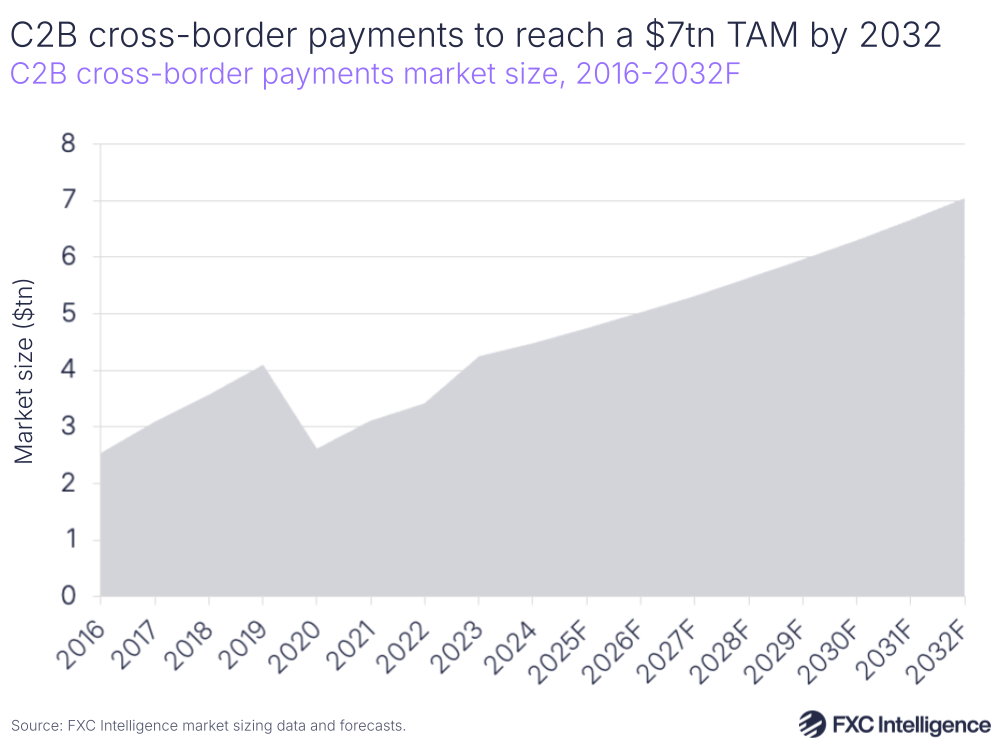
B2C payments, meanwhile, covers cross-border payments from businesses to consumers, and includes the payment of international workers, including both formal employee compensation and those remunerated through the gig economy via organisations such as Uber. It also includes other ad-hoc or sector-specific cross-border payments, including social media payouts, across brands such as Substack, YouTube and Etsy.
The 2024 TAM for cross-border B2C payments is below that of C2B, at $1.9tn, although this area is set to grow significantly. FXC Intelligence’s forecasts show B2C payments climbing by 130% between 2024 and 2032, with a CAGR of 11%, to reach $4.3tn. This is also higher than the growth rate over the last eight years, when B2C saw a CAGR of 9.2% between 2016 and 2024.
Much of this growth is being driven by the continued rise of the gig economy, and the growing numbers of payouts to participants in this sector globally. There are also ongoing increases in cross-border payments to creators and influencers, aided in part by increasing reach, sophistication and complexity of social media platforms.
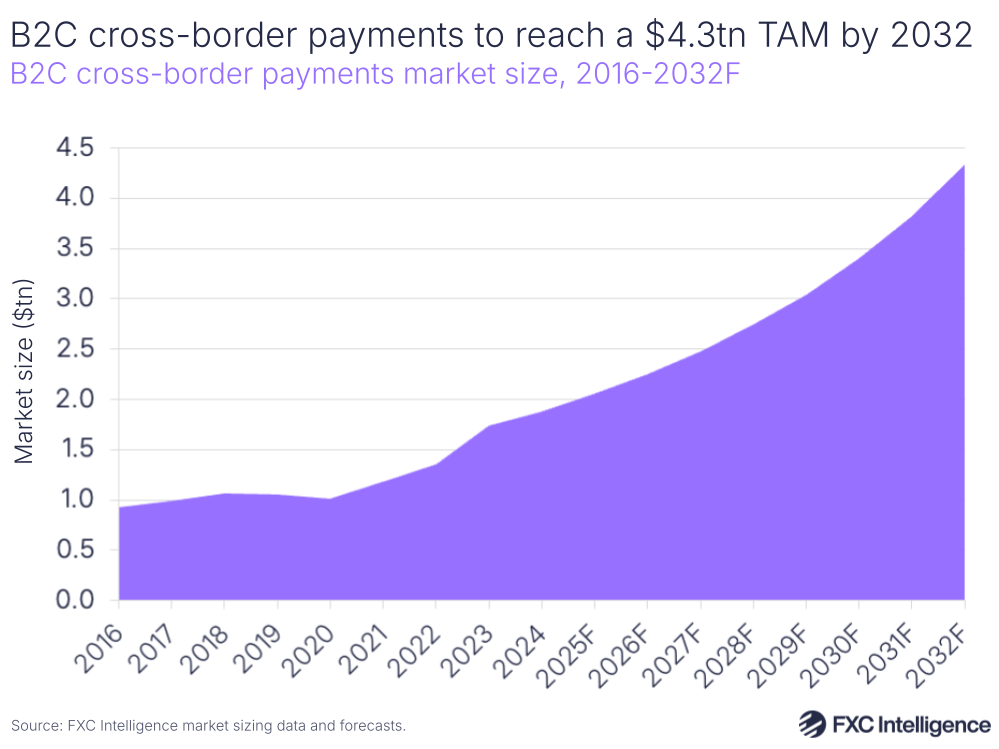
Learn more about Partnership Connect by FXC Intelligence
Which sectors are driving the most market growth for cross-border payments?
While the overall non-wholesale cross-border payments market is set to see a CAGR of 5.7% between 2024 and 2032, increasing its size by 56%, not all segments will grow equally. Despite its relatively small TAM, B2C leads on growth over the period, shifting it from the smallest segment in 2024 to the second smallest in 2032.
Both C2B and C2C, meanwhile, are set to see growth at a similar rate to the overall retail cross-border payments market, with CAGRs of 5.8%. While large enterprise B2B is set to have a CAGR of 5.5%, SMB will see slightly slower growth over this period, with a CAGR of 4.9% between 2024 and 2032.
However, when splitting B2B across goods and services, rather than large enterprise or SMB, the picture is slightly different, with services set to grow at a faster rate than goods over the next eight years. While B2B goods is projected to increase by a CAGR of 4.9% between 2024 and 2032, B2B services is forecast to climb at a CAGR of 6.4% over the same period.

Analysis of digital’s contribution to the services market also provides some additional insights. While services overall saw a cross-border market size of $7.7tn in 2024, $3.9tn of this – 50% – is services that are delivered digitally. However, this share has seen an interesting evolution over time.
In 2016, it sat at 41%, climbing slowly but steadily over the following years as digital services became more widespread and widely adopted in the B2B area. However, in 2020 it rose to 58%, up 15 percentage points on the previous year, as the pandemic drove a small upswing in digitally delivered cross-border B2B services alongside a sharp drop in non-digital B2B services.
This share contracted slightly although remained elevated in 2021, but has since reduced as non-digital services have rebounded. However, as of 2024 this has again begun to grow, and our forecast shows that by 2032 digitally delivered services will account for 58% of all services.
While non-digital services are set to see consistent, steady growth over the next few years, with a CAGR of 4.2% between 2024 and 2032, digital services are forecast to see stronger growth, with a CAGR of 8.3% over the same period.
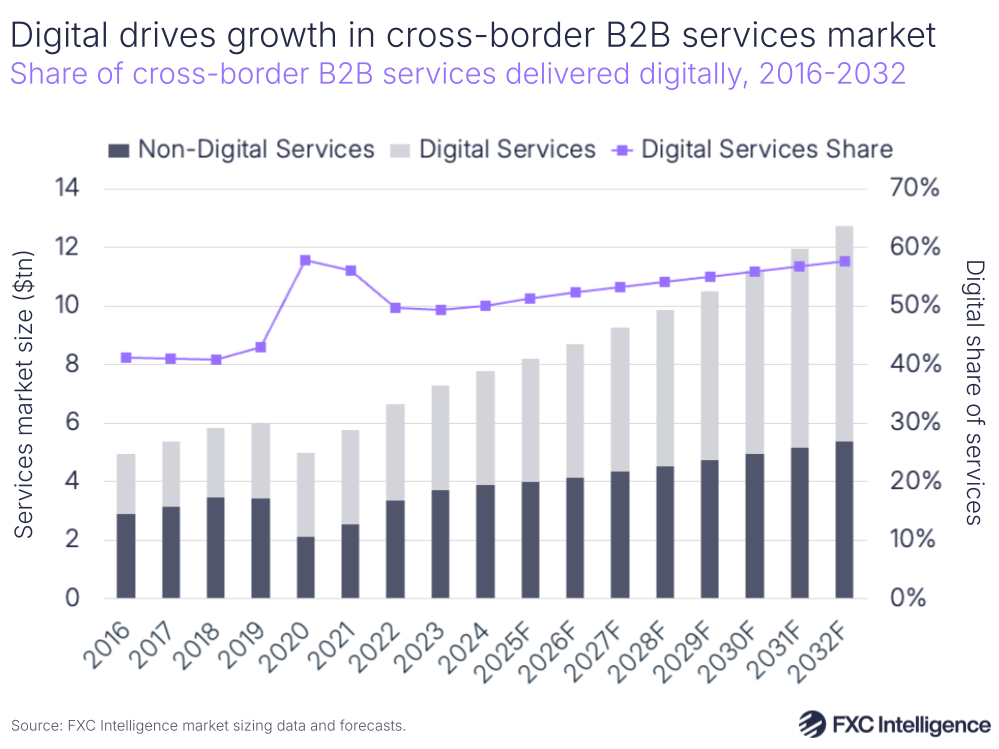
Accessing FXC Intelligence’s market sizing data
FXC Intelligence has developed rich, highly granular datasets on the size of the total addressable cross-border payment market at a country and corridor level for each segment of the industry, providing market sizing datasets that can be both leveraged independently or combined with other core datasets and platforms to build a comprehensive industry strategy.
As the market leader in cross-border payments data, our products and solutions are critical to many leading companies in the industry, including some of the world’s biggest banks, technology companies, payment providers and NGOs.


